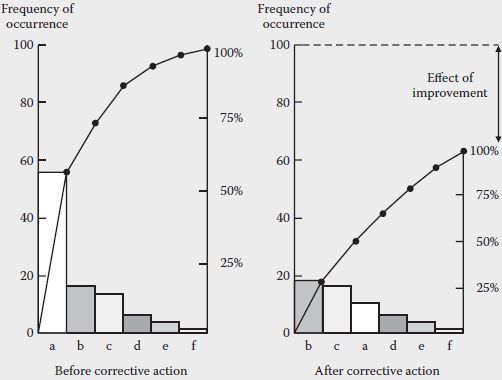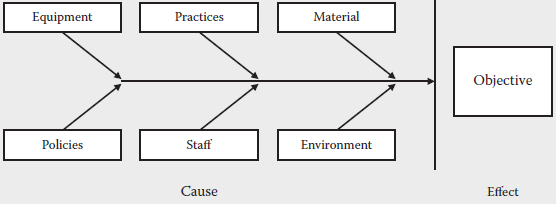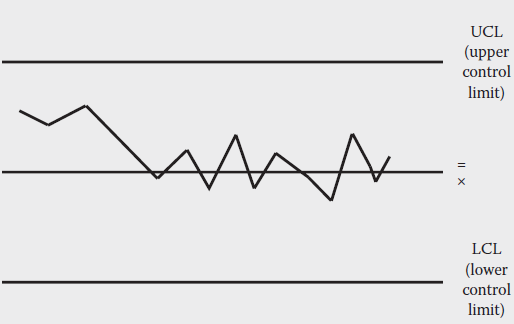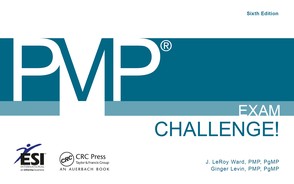Section 5
Project Quality Management
What is Project Quality Management?
ANSWER
The performing organization’s processes and activities that determine quality policies, objectives, and responsibilities, which ensure that the project will satisfy the needs for which it was undertaken.
[Planning, Executing, and Monitoring and Controlling]
2 QUESTION
Three standard deviations on either side of the mean of a normal distribution will contain approximately what percentage of the total population?
ANSWER
99.7%
[Monitoring and Controlling]
What are control limits as used in control charts?
ANSWER
Control limits (upper and lower) define the natural variation of a process. Points within the limits generally indicate normal and expected variation. Points outside the limits generally indicate that something has occurred that requires special attention because it is outside the natural variation in the process.
[Planning, Executing, and Monitoring and Controlling]
4 QUESTION
What is the difference between grade and quality?
ANSWER
Grade is a category assigned to a product or service whose functional use is similar but whose technical characteristics differ. Quality is the degree to which a set of characteristics fulfills requirements. Low quality always is a problem; low grade may not be.
[Planning and Monitoring and Controlling]
What tool is used to present the information below?

ANSWER
A Pareto diagram (or chart).
[Planning, Executing, and Monitoring and Controlling]
6 QUESTION
Define kaizen.
ANSWER
It is the Japanese term for continuous improvement.
[Executing]
How does the temporary nature of a project affect quality management?
ANSWER
Investments in product quality improvement, such as defect prevention and appraisal, must be borne by the performing organization because the project may not last long enough to realize rewards.
[Executing]
8 QUESTION
What is gold-plating? Describe its value.
ANSWER
Giving the customer more than what was required.
It has no value; exceeding specified requirements is a waste of time and money with no value added to the project. The customer should expect and receive exactly what was specified—no more, no less.
[Planning]
What is the purpose of a control chart?
ANSWER
To determine whether a process is stable or has predictable performance.
[Planning, Executing, and Monitoring and Controlling]
10 QUESTION
What is plan quality management?
ANSWER
Identifying project quality requirements and/or standards for project deliverables and documenting how the project will demonstrate compliance with quality requirements.
[Planning]
Is perform quality assurance a managerial or technical function?
ANSWER
Managerial.
[Executing]
12 QUESTION
What should the project manager do if the performing organization does not have a quality policy?
ANSWER
Work with the project management team to develop a quality policy for the project and ensure that project stakeholders are aware of the quality policy.
[Planning]
What is the purpose of a flowchart?
ANSWER
To graphically depict the relationships among steps in a process (including activities, decisions points, and the order of processing). In planning, flowcharting helps the project team anticipate quality problems. In monitoring and controlling, it can pinpoint a failing process step(s) and help identify potential process improvement opportunities.
[Planning, Executing, and Monitoring and Controlling]
14 QUESTION
What is the effect of sample size on the standard deviation?
ANSWER
Whenever sample size increases, the standard deviation decreases.
[Monitoring and Controlling]
Why is the project scope statement a key input to plan quality management?
ANSWER
It documents the product description, major project deliverables, and acceptance criteria. It often contains details of technical issues and other concerns that can affect quality planning.
[Planning]
16 QUESTION
What is the Rule of Seven?
ANSWER
It means that there are seven consecutive points (measurements) outside the upper or lower control limits in a control chart, indicating a process that is out of control.
[Planning, Executing, and Monitoring and Controlling]
On a scatter diagram, what is the significance of the closer the points are to a diagonal line?
ANSWER
The more closely the two variables measured are related.
[Planning, Executing, and Monitoring and Controlling]
18 QUESTION
What is rework?
ANSWER
Action taken to ensure that a defective or nonconforming item complies with requirements or specifications.
[Monitoring and Controlling]
What is benchmarking?
ANSWER
Compares actual or planned practices to those of comparable organizations to identify best practices, generate ideas for improvement, and provide a basis for measuring performance
[Planning, Executing, and Monitoring and Controlling]
20 QUESTION
Define quality.
ANSWER
“The degree to which a set of inherent characteristics fulfils requirements.” (ISO 9000)
[Planning, Executing, and Monitoring and Controlling]
Name the two major categories of the cost of nonconformance. Give at least two examples of each.
ANSWER
Internal Failure Costs
- Scrap
- Rework
External Failure Costs
- Liabilities
- Warranty work
- Lost business
[Planning]
22 QUESTION
List the seven basic tools of quality.
ANSWER
- Cause-and-effect diagrams
- Flowcharts
- Checksheets
- Pareto diagrams
- Histograms
- Control charts
- Scatter diagrams
[Planning, Executing, and Monitoring and Controlling]
What is meant by cost of quality?
ANSWER
The total cost of all efforts related to quality throughout the product life cycle, including the cost of conformance and the cost of nonconformance.
[Planning]
24 QUESTION
How are cause-and-effect diagrams used in Project Quality Management?
ANSWER
As a tool and technique in all three processes to describe a problem as a gap to be closed or an objective to be achieved. The causes are found by looking at the problem statement and asking why until actionable root causes are identified, or reasonable possibilities on the diagram have been exhausted.
[Planning, Executing, and Monitoring and Controlling]
What is the voice of the customer (VOC)?
ANSWER
Answer: A planning technique used to provide products, services, or results reflecting customer requirements by translating appropriate ones into technical requirements for each phase of the project or product.
[Planning]
26 QUESTION
What is meant by design of experiments? Where is it most frequently applied?
ANSWER
Analytical technique used to help identify the variables that have the most influence on the outcome of a process or procedure. As an example, it is used during the plan quality management process to determine the number and type of tests and their impact on the cost of quality.
[Planning]
What is the difference between an attribute and a variable?
ANSWER
An attribute is a quality characteristic that is classified as either conforming or nonconforming to specifications or requirements.
A variable is a quality characteristic that is rated on a continuous scale that measures the degree of conformity to the specifications or requirements.
[Monitoring and Controlling]
28 QUESTION
What is the principal purpose of the quality management plan?
ANSWER
To describe how the organization’s quality policies will be implemented and how the project management team plans to meet the quality requirements set for the project
[Planning]
What are quality checksheets? How are they used?
ANSWER
As a checklist in gathering data to organize facts in a way that will facilitate effective collection of useful data about a quality problem.
They are one of the seven basic quality tools and are used throughout project quality management.
[Planning, Executing, and Monitoring and Controlling]
30 QUESTION
The upper and lower control limits are set at what level of standard deviation?
ANSWER
± 3 s
[Planning, Executing, and Monitoring and Controlling]
Define perform quality assurance.
ANSWER
The process of auditing quality requirements and results from quality control measurements to ensure that appropriate standards and operational definitions are used.
[Executing]
32 QUESTION
What is a quality audit? What are its five objectives?
ANSWER
Structured review of quality management activities to ensure project activities are in compliance with all policies, processes, and procedures.
- Identifies good/best practices
- Identifies gaps/shortcomings
- Shares best practices with other projects across the organization
- Offers process improvement assistance
- Ensures updating of the organization’s lessons learned repository
[Executing]
Who is ultimately responsible for providing the resources needed to ensure quality in any given project?
ANSWER
Management – usually the project sponsor.
[Planning, Executing, and Managing and Controlling]
34 QUESTION
What is control quality?
ANSWER
Monitoring and recording results of executing the quality activities to assess performance and recommend necessary changes.
[Monitoring and Controlling]
Give seven examples of costs of conformance.
ANSWER
- Training
- Document processes
- Equipment
- Time to do it right
- Testing
- Destructive testing loss
- Inspections
[Planning]
36 QUESTION
In which project phase is control quality performed?
ANSWER
Control quality is performed throughout all phases of the project life cycle.
[Monitoring and Controlling]
What is a Pareto diagram? How is it used in control quality?
ANSWER
A special form of vertical bar chart used to identify the vital few sources responsible for causing cost of a problem’s effect; organized into categories to measure either frequencies or consequences.
It puts issues into an easily understood framework in which rank ordering is used to focus corrective actions.
[Monitoring and Controlling]
38 QUESTION
When is a process “in control”? “Out of control”?
ANSWER
In control when the process is within acceptable limits – within the upper and lower limits on a control chart
Out of control if a data point exceeds a control limit; seven consecutive plot points are above the mean; or seven consecutive plot points are below the mean
[Planning, Executing, and Monitoring and Controlling]
In what process should sample frequency and sizes be determined?
ANSWER
Plan quality management process.
[Planning]
40 QUESTION
What process improvement model is used as the basis for quality improvement as defined by Shewhart?
ANSWER
Plan-do-check-act cycle.
[Planning]
What is the difference between a special cause and a random cause?
ANSWER
A special cause is an unusual event and indicates a process is “out of control”; a random cause is normal process variation, and indicates a process is “in control.”
[Monitoring and Controlling]
42 QUESTION
What are the updates to organizational process assets as a result of perform quality control?
ANSWER
- Completed checklists
- Lessons learned documentation
[Monitoring and Controlling]
What is the difference between specification limits and control limits?
ANSWER
Specification limits establish the range of acceptable results. Control limits are a threshold that can indicate if the process is out of control.
A process could be in control in which the results fall within the computed control limits, but are outside the acceptable specification limits, which results in an unacceptable outcome.
[Planning, Executing, and Monitoring and Controlling]
44 QUESTION
What is inspection?
ANSWER
Examining or measuring whether an activity, component, product, result, or service conforms to specified requirements.
[Monitoring and Controlling]
What is root cause analysis?
ANSWER
An analytical technique used to determine the basic underlying reason that causes variance, defect, or a risk. A root cause may underlie more than one variance, defect, or risk.
[Planning, Executing, and Monitoring and Controlling]
46 QUESTION
What is the underlying concept of a Pareto diagram?
ANSWER
A relatively large majority of the problems or defects (80 percent) are the result of a small number of causes (20 percent). Also called the “80/20” rule.
[Planning, Executing, and Monitoring and Controlling]
What is the purpose of approved changed requests review in perform quality control?
ANSWER
It is a tool and technique to ensure all approved change requests were implemented.
[Monitoring and Controlling]
48 QUESTION
What are verified deliverables in perform quality control?
ANSWER
A goal of the process is to determine the correctness of deliverables. The result of performing this process is verified deliverables, which are an input to Validate Scope.
[Monitoring and Controlling]
Who developed the tool represented by the following figure? What are three names for it?

ANSWER
Ishikawa
- Cause-and-effect diagrams
- Ishikawa diagrams
- Fishbone diagrams
[Planning, Executing, and Monitoring and Controlling]
50 QUESTION
What do the upper control limit and lower control limit represent on this figure?

ANSWER
3σ from the mean.
[Planning, Executing, and Monitoring and Controlling]
Modern quality management emphasizes some of the same basic principles of project management. Provide five examples.
ANSWER
- Customer satisfaction
- Prevention over inspection
- Continuous improvement
- Management responsibility
- Cost of quality
[Planning, Executing, and Monitoring and Controlling]
52 QUESTION
What are ten additional quality planning tools that often are used to better define quality requirements and plan effective quality management activities?
ANSWER
- Brainstorming
- Force field analysis
- Nominal group technique
- Affinity diagrams
- Process decision program charts
- Interrelationship diagraphs
- Tree diagrams
- Prioritization matrices
- Activity network diagrams
- Matrix diagrams
[Planning and Executing]
What is a quality metric? Provide seven examples.
ANSWER
An operational definition that describes in specific terms a project or product attribute and how the control quality process will measure it.
- On-time performance
- Budget control
- Defect frequency
- Failure rate
- Availability
- Reliability
- Test coverage
[Planning, Monitoring and Controlling]
54 QUESTION
What is the primary benefit of meeting quality requirements? What is the primary cost?
ANSWER
The primary benefit is less rework, which translates into higher productivity, lower costs, and increased stakeholder satisfaction.
The primary cost is the expense associated with project quality management activities.
[Planning]
In what processes are quality checksheets used?
ANSWER
- Plan Quality Management
- Perform Quality Assurance
- Perform Quality Control
[Planning, Executing, and Managing and Controlling]
56 QUESTION
How are quality control measurements used in perform quality assurance?
ANSWER
To analyze and evaluate the project’s processes against the standards of the performing organization or the specified requirements
[Executing]
Perform quality assurance is performed in what phase?
ANSWER
Throughout all phases of the project life cycle.
[Executing]
58 QUESTION
What is process analysis? When is it used?
ANSWER
Examination of the individual steps in a process to identify needed improvements. The analysis examines problems experienced, constraints experienced, and non-value-added activities identified during process operation. It includes root cause analysis.
As a tool and technique in perform quality assurance.
[Executing]
What are four areas to consider in the process improvement plan?
ANSWER
- Process boundaries
- Process configuration
- Process metrics
- Targets for improved performance
[Executing]
60 QUESTION
If a project is experiencing quality problems, should the project manager devote more project resources to inspection or to prevention?
ANSWER
Prevention, because preventing a problem is far less costly, in the long run, than fixing one, especially if the customer finds the problem.
[Planning]
